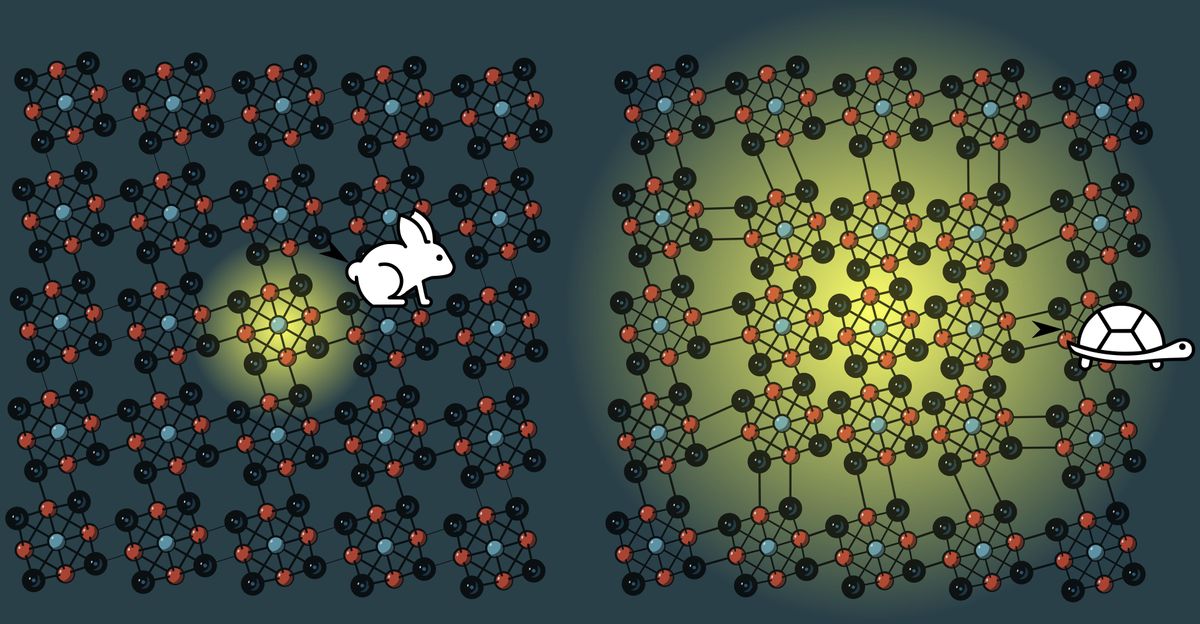Scientists have discovered what they say is the fastest and most efficient semiconductor yet. Although the new material is made using one of the rarest elements on Earth, the researchers suggest counterparts made from more abundant materials may be discovered that operate comparably fast.
Semiconductors underpin virtually all modern electronics. However, as commonplace as they’ve become, semiconductors still face constraints when it comes to their speed.
One reason for these speed limits has to do with atomic vibrations, which travel as quasiparticles known as phonons within solid materials. Phonons can scatter the particles that carry energy and information around electronics. These are typically electrons, but are sometimes more exotic particles, such as excitons (electrons bound to their positively charged quasiparticle counterparts, electron holes).
In a new study that overcame the problems that phonons can cause, researchers experimented with a semiconductor made out of Re6Se8Cl2—a molecule built out of rhenium, selenium, and chlorine. The semiconductor’s atoms form clusters called “superatoms” that each behave like one big atom, but with different properties than the elements used to build them. Each cluster consists of an octahedron made of six rhenium atoms nestled within a cube made of eight selenium atoms, with a chlorine atom on the top and bottom of the cluster.
“Now that we know what structural and electronic properties are needed...there is good likelihood that we will find earth-abundant alternatives to this rhenium-based material.” —Milan Delor, Columbia University
When excitons come in contact with phonons in Re6Se8Cl2, instead of scattering, they actually bind together, forming new quasiparticles called acoustic exciton-polarons. These quasiparticles are capable of ballistic, or scatter-free, flow.
In experiments at room temperature, acoustic exciton-polarons in Re6Se8Cl2 moved twice as fast as electrons in silicon. This is the first material in which anyone has detected sustained room-temperature ballistic exciton movement.
Electrons in semiconductors usually scatter after traveling just nanometers, on a timescale measured in femtoseconds. In contrast, the acoustic exciton-polarons in Re6Se8Cl2 successfully crossed several micrometers (about 3 orders of magnitude farther) over the course of a nanosecond (about 6 orders of magnitude longer). Given that polarons can last for about 11 nanoseconds, the scientists think that acoustic exciton-polarons could cover more than 25 micrometers before scattering.
These quasiparticles are controlled by light rather than by an electric current. This means processing speeds in devices based on them could reach femtoseconds, a million times as fast as the speeds achievable with current gigahertz electronics.
The researchers did not originally test Re6Se8Cl2 thinking it would prove a new and improved semiconductor. Instead, they were testing lab microscopes on a material they had thought should not have conducted much of anything. They ended up seeing the fastest semiconductor they had ever seen, says study senior author Milan Delor, a physical chemist at Columbia University in New York City.
After two years of work, Delor and his colleagues now believe they understand why Re6Se8Cl2 displays such extraordinary behavior. As it turns out, excitons in this semiconductor move very slowly compared to electrons in silicon. However, this means that the excitons can pair up with equally slow-moving phonons. The resulting quasiparticles are “heavy,” meaning they move slowly but steadily. In contrast, electrons are “light,” meaning they bounce around too much to actually travel very far or fast in the end.
Re6Se8Cl2 is also, along with graphite and hexagonal boron nitride, what’s called a van der Waals material. These materials are made of stacked films of smooth, atomically thin layers held together by weak electric forces known as van der Waals interactions, the same forces that often make adhesive tapes sticky. Previous research has suggested that when atom-thin sheets of different van der Waals materials are placed on top of each other to form so-called heterostructures, novel hybrid properties can emerge.
One major problem that Re6Se8Cl2 faces is that rhenium is one of the rarest elements on Earth. This makes Re6Se8Cl2 very expensive and unlikely to ever make its way into a commercial product.
However, Re6Se8Cl2 belongs to a family of superatomic semiconductors that share structural and electronic properties. Many of these materials are made of more abundant elements. This includes a recently discovered all-carbon material namedgraphullerene, which resembles balls of carbon arranged in sheets.
“Now that we know what structural and electronic properties are needed to achieve the new transport regime discovered in this work, there is good likelihood that we will find earth-abundant alternatives to this rhenium-based material that also show impressive transport properties,” Delor says.
All in all, the researchers suggest acoustic exciton-polarons “could be a general way to achieve long-range energy flow in different materials that traditionally would not be expected to show good transport properties,” Delor says. “It’s a surprising finding that we’re looking forward to applying to more systems.”
Another caveat of this work is that it relies on excitons instead of electrons. “Although excitons carry information and energy just like electrons, they are not necessarily compatible with current hardware used in the semiconductor industry,” Delor says. Therefore, the applications for these semiconductors “would likely be different than those for traditional semiconductors.”
Potential devices made from these semiconductors may include “ballistic transistors” that use excitons instead of electrons. These could serve as very efficient light detectors, or find use in computing to reduce energy losses and increase performance, Delor says.
The scientists detailed their findings in the 27 October issue of the journal Science.
Charles Q. Choi is a science reporter who contributes regularly to IEEE Spectrum. He has written for Scientific American, The New York Times, Wired, and Science, among others.



